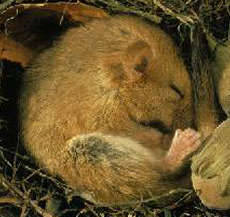Overview
 Order: Rodentia
Order: Rodentia
Family: Gliridae
Species: Muscardinus avellanarius (Hazel Dormouse)
IUCN Red List: UK: Vulnerable, Global: Least Concern.
Distribution: found mainly in southern counties from Cornwall to Kent northwards to Herefordshire and into Wales. They are occasionally recorded in the north but not found in Scotland.
Habitat: deciduous woodland with plenty of scrub and undergrowth resulting from coppicing (cutting trees and woody shrubs to ground level periodically to provide wood for various purposes).
Description: chubby build; bright golden-brown colour with creamy-white underparts. Large, prominent, shiny, black eyes and small, rounded ears. Fluffy tail.
Size: head and body about 70mm (2in); tail of similar length. Adult weighs about 17g (weight of two £1 coins) and up to 40g at the start of hibernation.
Life-span: up to 5 years in the wild; 6 years in captivity.
Food: flowers, pollen, fruit, nuts and insects. Hazel, honeysuckle, bramble and oak are particularly important as food sources.
Read More: Introduction
